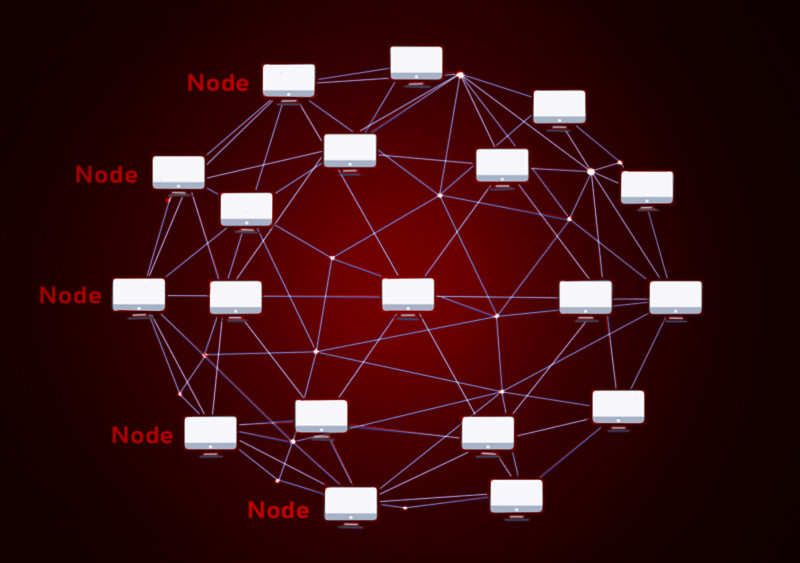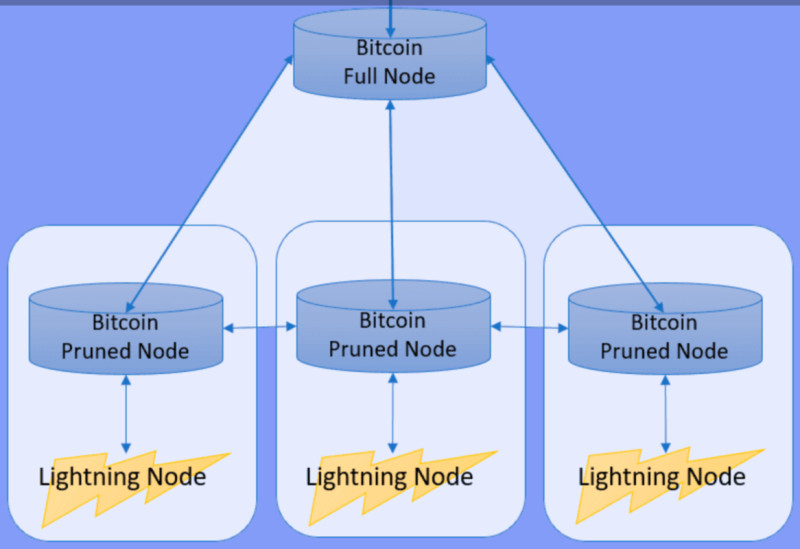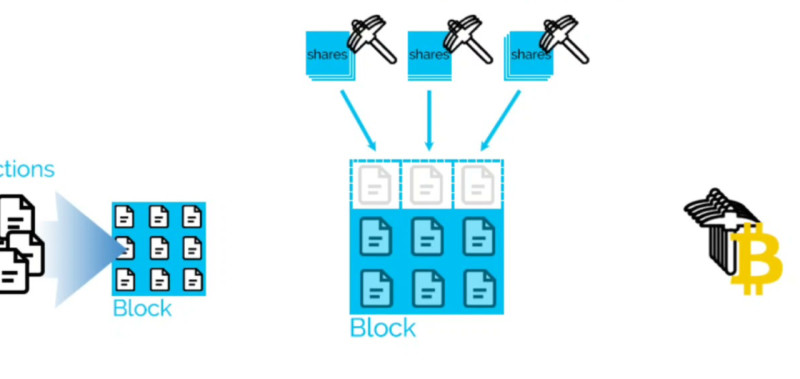
Cryptocurrencies represent a decentralized system, which means that they are not controlled by banks or any other governmental authorities.
We also recommend reading Basics of cryptocurrencies.
The most important part of this unique system is cryptocurrency nodes. In fact, the entire world of cryptocurrencies relies on them. The industry leader, Bitcoin, currently has 16,000 nodes, while the second-largest cryptocurrency by market capitalization, Ethereum, has noticeably fewer, only about 7,000.
In this article, we will explain what cryptocurrency nodes (often referred to as "nodes") are, how they function in the system, and why it is commonly believed that the entire world of digital assets would not exist without them.
What are nodes?

It is important to understand that absolutely every participant in the blockchain network functions as a node.
Cryptocurrency nodes are computers equipped with a specific program, such as a Bitcoin wallet.
Nodes are connected with other similar computers, which together form a unified cryptocurrency network.
Nodes (or network participants) also have a third name. They are often called “clients,” which serve as wallets.
Nodes function exclusively within a peer-to-peer network, which enables them to communicate with one another.
The following protocols are used in such a network:
• Proof-of-Work (PoW) consensus
• Proof-of-Stake (PoS)
These protocols facilitate the propagation of data about new blocks and new transactions.
But why are these cryptocurrency nodes needed? In the blockchain system, a node acts as a fundamental unit.
In decentralized systems, where mining of new coins is not possible and where other methods of data protection are applied, the presence of nodes is simply inevitable.
Nodes have specific tasks they perform depending on the blockchain structure:
• Ensure compliance with network principles
• Share data about operations and balances
• Store copies of all confirmed transactions
• Detect and reject all incorrect transactions
• Ensure the security and unity of the entire peer-to-peer network
• Participate in the generation of new blocks
What types of nodes exist?

As we can see, the tasks performed by nodes in the blockchain system vary greatly. The same variety is observed among the nodes themselves.
Cryptocurrency nodes offer a wide range of functions. For example, the NEM network actively uses supernodes, whereas the Basic Attention Token application does not utilize them for mining.
Although all nodes technically have equal rights, some of them play a more important role in maintaining and operating the network. However, not all nodes are capable of storing a full copy of the blockchain or verifying transactions; some can even function outside the main network.
In a blockchain system, two main types of nodes can be distinguished:
• Full nodes
• Light (or lightweight) nodes
In addition, the crypto industry features specialized nodes: pruned nodes, archive nodes, mining nodes, staking nodes, lightning nodes, and masternodes. Below, we will take a closer look at each of these types.
Full nodes
These are devices connected to the cryptocurrency network that store a complete and up-to-date copy of the blockchain database. They contain the entire blockchain history, including all generated blocks.
The total number of such full nodes in a network directly impacts critical factors such as the system’s reliability, scalability, and transaction confirmation speed. The formula is quite simple—the fuller nodes there are, the more stable and resilient the entire peer-to-peer system becomes.
It is generally believed that if at least one device stores a full copy of the network, the cryptocurrency network can be restored.
The distributed ledger is supported and regularly updated thanks to numerous independent computers and servers scattered across the globe.
Full cryptocurrency nodes contribute to the system’s security, as stopping it would require the destruction of all such nodes.
Information on the total number of existing full nodes is publicly available. For instance, as of June 7, 2024, there were 16,000 full nodes maintaining the operation of the Bitcoin network.
Why is setting up a full node a good idea?
The answer is simple — it provides an opportunity to directly support the network of your chosen coin and avoid relying on other full nodes to process your data. You can both deploy your own node and store a copy of the blockchain. This approach significantly increases the level of security, although it does require considerably more time for setup.
Light nodes
Light nodes (or lightweight nodes) function similarly to electronic wallets, downloading only block headers. This method significantly saves hard drive space for users, which is undoubtedly very convenient.
According to statistics, only 1% of users of the first cryptocurrency (referring to Bitcoin, of course) possess a full node.
Most network users, as practice shows, prefer to use these lightweight nodes. They do not store the full version of the blockchain and verify transactions using only block headers.
It is important to acknowledge that such nodes do not have the full capabilities of complete blockchain elements and depend heavily on full nodes. This dependency makes them vulnerable to fraudulent attacks, particularly in the case of automated services used for digital currency exchange.
Light nodes are also known as simplified wallets or Simplified Payment Verification (SPV) clients. These nodes are considered the most compact in the cryptocurrency ecosystem.
Thanks to the fact that only block headers are stored, these cryptocurrency nodes enable the generation of multi-currency wallets that can be installed on smartphones or as browser extensions.
SPV applications operate with the blockchain through a remote node. They do not affect the integrity or security of the entire network and are not capable of validating other transactions.
Despite their limitations, lightweight nodes remain extremely popular due to their ease of use, fast performance, and minimal hardware requirements.
Pruned nodes
It is important to note that not every network participant is capable of maintaining a full node due to the significant size of the blockchain and high storage requirements.
For example, in July 2021, storing the Bitcoin database required at least 352 GB of free space on a hard drive.
If sufficient space is unavailable, one can use a so-called pruned node.
Pruned nodes operate as follows: the wallet downloads blocks starting from the very beginning of the chain. However, once a preset limit is reached, it begins deleting the oldest blocks while retaining their headers and the chain structure information.
For instance, if you set a storage limit of 550 MB, you will only need to retain the latest blocks that fit within this limited space. However, to transition into this state, you must first complete a full synchronization of the blockchain from its genesis.
Thus, pruned nodes are still considered full nodes that can verify transactions and participate in achieving consensus.
Archive nodes
Archive cryptocurrency nodes are full nodes that store the entire history of the blockchain (more precisely, from the very beginning of its inception) and actively participate in the processing of all transactions.
Archive nodes operate constantly, continuously, and autonomously, but at the same time, occupy significant space on the hard drive, which may not be pleasing to the user. Depending on the settings, such nodes may either participate in the mining of new cryptocurrencies or be completely separated from such a function.
A server is required for archive nodes to hold the information of the full blockchain version. Their main role lies in maintaining consensus and in verifying blocks.
The most important difference between a pruned node and an archive node lies in the amount of space occupied on the hard drive of a server or personal computer.
Archive nodes vary in type depending on their functionality. Some are capable of adding new blocks to the blockchain, while others do not possess such a unique ability.
Mining nodes

The primary function of mining nodes is the extraction of new blocks for the blockchain. This process requires complex cryptographic calculations, where hardware resources play a key role.
Graphics cards, processors, or specialized ASIC devices created exclusively for working with specific cryptocurrency protocols may be used for mining.
There exist both full and lightweight mining nodes. Once a new block is found and finally confirmed, it is added to the blockchain, and miners receive a reward for their efforts.
Such nodes exist exclusively in systems that operate on the Proof of Work (PoW) algorithm.
Staking Nodes
Not all systems use the Proof of Work (PoW) algorithm in their operation. Many of them are based on the Proof of Stake (PoS) algorithm, and some are capable of combining both PoW and PoS in the creation of new blocks.
Nodes that participate in the staking process are usually full nodes and are known as staking nodes. This process requires the installation of specialized software, including heavy wallets.
Next, it is necessary to synchronize this software with the blockchain and transfer cryptocurrency to the wallet. It is important to ensure a continuous internet connection for interaction with other network nodes.
Owners of such nodes receive a reward, the size of which depends on the proportion of invested funds, the duration of their freezing, and a random element.
In staking, the key factor is not so much the volume of computing power as the amount of cryptocurrency invested. This is the main difference between earning from staking nodes and mining.
Lightning Nodes
Lightning nodes represent a unique type of node that does not fall under the standard functions of full or lightweight nodes.
Their primary purpose is to create a connection between users outside the main network. They achieve this through a unique technology known as SideChain (a network scaling technology that builds a parallel network with a two-way connection to the main chain).
Lightning nodes make it possible to significantly reduce the load on the main blockchain, substantially accelerate the speed of information transfer, and make the use of cryptocurrencies more convenient.
In the lightning network, by the way, transaction fees are among the lowest—approximately 10 to 20 satoshis.
This approach eliminates delays caused by waiting for confirmation of each transaction and significantly reduces the amount of redundant data in the blockchain. Network participants using this model can successfully interact with each other while reducing the unnecessary load on the system.
Moreover, if someone else intends to use the same payment channel, lightning nodes react instantly—they immediately find the route with the fewest intermediaries and the lowest fee. All of this, undoubtedly, benefits the user and significantly speeds up the entire transaction process.
Masternodes

Masternodes are cryptocurrency nodes that do not add new blocks to the chain but only record and verify transactions. They are equipped with management and regulatory functions within the framework of their blockchain protocol.
Masternodes were first implemented in the Dash cryptocurrency system in March 2014, where they performed the following tasks:
• Recording and verification of instant transfers
• Recording and verification of private transfers
• Assigning network usernames instead of cryptocurrency addresses
Each masternode has a vote in decision-making regarding changes to the Dash network protocol. These nodes operate based on collateral (similar to the PoS protocol), where operators must hold a large amount of cryptocurrency to manage the node. For this, they receive a certain income, credited annually.
This operational principle ensures financial incentive for important nodes, which ultimately increases both the stability and loyalty of the entire network.
Many people wonder which is better—a masternode or a full node. Masternodes and full nodes are actually quite similar in their functions, but if you intend to earn income periodically, it is better to launch a masternode.
With masternodes, you can count on income for services, but it is important to consider the initial investment you place as a deposit in the masternode.
Another potential source of income could be a staking node, which offers you regular passive income, growing in proportion to the amount of funds you invest.
Node after fork
Now that you know what types of cryptocurrency nodes exist and are familiar with how they operate, it is time to examine how they are connected to network consensus and potential forks.
Changes in the code of a cryptocurrency can be caused by a variety of reasons—transitioning to another consensus protocol (for example, from PoW to PoS), identifying critical bugs, introducing masternodes, or scaling the network.
If there is no agreement among at least 51% of full nodes, the proposed change to the blockchain will be rejected. However, if a significant portion of the crypto community decides to adopt the change, forks come to the forefront.
A developer may decide to create a new client using the original cryptocurrency code and make the appropriate modifications. Users who wish to follow this course download the latest version and choose to support the forked version of the blockchain.
As a rule, the final decision to conduct a fork is made through a vote among full node holders.
There are two types of forks:
| Hard Fork | Soft Fork |
| A code change leads to modifications in the network’s consensus algorithm. As a result, a chain of blocks is created that becomes incompatible with the previous version. Nodes that support the change update their software and form the ecosystem of the new coin. This can reduce the number of full nodes in the network and affect its security. | This fork means a software update in which the new version of the blockchain remains compatible with the previous one. Updating is not mandatory in this case; both versions can continue to exist in parallel. An example of such a fork: the implementation of the SegWit algorithm into the Bitcoin blockchain on August 24, 2017. For the next four years, both the updated nodes and those running the original software could carry out and confirm Bitcoin transactions. Notably, the community did not split, and the system’s integrity was preserved. |
Node launching
If you are planning to launch a full node, it is extremely important to consider compliance with specific technical requirements. In the past, relatively weak hardware could be used for this purpose, but today that is no longer sufficient. A large amount of memory and considerable processor power now play, arguably, the key role.
Before installation, it is important to review the recommended technical requirements for hardware, which may vary depending on the specific cryptocurrency. For example, launching a full Bitcoin node will require the following specifications:
- The latest version of the Windows, Mac OS, or Linux operating system is required.
- At least 500 GB of free disk space with a minimum read speed of 100 MB/s.
- An SSD capable of 68 MB of random write and 30.9 MB of random read operations.
- A minimum of 8 GB of RAM.
- A broadband Internet connection with a minimum download speed of 400 kilobits (50 kilobytes) per second and unlimited data traffic.
After installing the client software and updating the database, it is necessary to allow incoming connections through TCP port 8333 in the firewall settings.
Common issues encountered during manual configuration:
- Limited bandwidth or unstable Internet connection, which may require a reboot if synchronization is interrupted.
- The risk of hackers embedding viruses into the blockchain, which will not infect the computer but may trigger antivirus reactions and disrupt the functioning of Bitcoin Core, especially on Windows.
Thus, launching a full cryptocurrency node requires significant investment in hardware, access to a stable Internet connection, and the user’s ability to work with the command line.
Using VPS for nodes

For those traders who wish to launch a personal node, it is recommended to use a Virtual Private Server (also referred to as a VPS).
It will eliminate the need to constantly defend against DDoS attacks and will provide sufficient bandwidth.
A VPS allows you to install multiple masternodes on a single server, requiring only a dedicated IP address for each one. Incidentally, renting a high-performance VPS will cost you significantly less than purchasing any powerful computer, which would still need to be supported with high-speed Internet.
It is worth noting that cryptocurrencies for the masternode are deposited on external equipment, which requires special security measures to protect the crypto wallet.
Which VPS providers should be considered? Here is a list of some of the best providers: Amazon EC2, DigitalOcean Droplets, Vultr, OVH, and Microsoft Azure.
Earning with nodes
Using the core components of blockchain as investment tools is becoming increasingly popular. This trend is explained by the declining profitability of mining and the growing number of digital currencies offering alternative earning opportunities. Moreover, each cryptocurrency operates using different protocols, which increases the potential for profit.
Harvesting is the process of earning rewards for node activity in the NEM network, which functions based on the Proof-of-Importance (PoI) protocol.
This method allows a single client to manage multiple accounts. The number of coins earned depends on the importance rating (or coefficient) of each account, which is calculated based on the amount of coins deposited, the transaction activity of the account, and the duration the coins are held in the wallet.
There are two main types of harvesting:
- Local harvesting – where one account is linked to one computer. Currently, this method is rarely used due to the high risk of deposit theft, as clients have access to the private key.
- Delegated harvesting – in this case, an intermediary account is used that does not control the balance of the main wallet.
Leasing is a relatively new earning method applicable to cryptocurrencies that use the Proof-of-Stake (PoS) consensus algorithm, such as the Waves coin.
To generate income, besides setting up a cryptocurrency node, you must have a certain amount of coins in your wallet. The minimum required amount is 1,000 coins. If you are unable to invest that much, you can use leasing by purchasing between 300 and 600 coins. You must then transfer these coins to your wallet and activate the leasing function.
Miners who receive coins via leasing are required to allocate a portion of their earnings to the owner of the leased coins. However, this feature can be disabled at any time.
Cryptocurrencies for earning via masternodes
The cryptocurrency market is a promising source of income. In addition to mining and trading on crypto exchanges, one can earn a decent profit by managing a masternode.
As of September 2021, a total of 224 cryptocurrencies were using masternodes within their blockchains.
Before choosing a cryptocurrency for investment, consider the following important aspects:
- The project’s current progress and future development roadmap
- The total number of cryptocurrency wallets that support this coin
- The minimum required number of coins to operate a masternode
- The amount of investment needed and the expected profitability of the cryptocurrency
How many nodes can you run on one computer?
This depends on the user’s hardware resources. Since only one instance of a wallet can be run at a time, you’ll need to use virtual machines to launch additional nodes.
If you choose to use a Virtual Private Server (VPS), it’s important not to overload it—aim to utilize no more than 80–85% of the available resources. Exceeding this threshold may lead to unstable node performance and, ultimately, your removal from the network due to poor hosting quality.
Recommended
Types of cryptocurrency








 Back to articles
Back to articles



